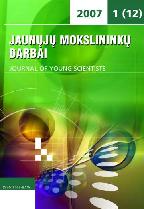Judesių korekcijos užsiėmimų įtaka Šiaulių specialiojo ugdymo centro mokinių laikysenai
Influence of Movement Correction Practice at Šiauliai Special Education Center Correcting Children‘S Posture
Author(s): Jūra Vladas Vaitkevičius, Deividas MinginasSubject(s): Social Sciences
Published by: VšĮ Šiaulių universiteto leidykla
Keywords: Posture; scoliosis; muscular tonicity; kinetic therapy.
Summary/Abstract: Incorrect posture, perverse posture and scoliosis are phrases heard and pronounced more and more often at educational institutions nowadays. In the computer and machine age posture disorder is a very common phenomenon among schoolchildren. The problem is especially relevant for children with cerebral paralysis as their body posture is extremely influenced by specific muscular tonicity and articular contractor not to mention unfitted school desks and time spent in front of the computer. In order to achieve the most optimum physical form these children’s body posture must always be under observation, exercises should be intensified and various methods and innovations applied. The aim of the research is to ascertain if children’s in the study posture, muscular power and tonicity have changed having applied the programme of movement correction activities. Changes in posture, muscular power, muscular tonicity and articular amplitudes of children with cerebral paralysis having applied movement correction activity programmes are compared in the work. Moreover, analysis and interpretation of the achieved results is presented in the work. Having accomplished the research the efficiency of activity programmes for movement correction has been confirmed. When various individual movement exercises and movement components correction in addition to kinetic therapy with GYMNIC balls and cooperation with the parents have been applied as well as positive influence of other therapies (massage, swimming pool etc.) and such activities as remedial exercise and physical education have been estimated it can be stated that schoolchildren’s posture deformations alternated a positive direction and the most optimal physical form. Schoolchildren with cerebral paralysis have inherent features of pervert posture (all 23 schoolchildren under investigation have had some posture disorder) and the duration of correction must be continued consistently, not allowing to form perverse body positions, muscular and articular contractors children’s posture must be controlled not only during the course of activities and various therapies, but also at home, during the lessons and in their free-time. When the activity programme of primal movement correction was complemented, adjusted and continued in the following school year, efficiency of the programme has answered the purpose as schoolchildren regained physical form more quickly and study results were better than those of the same month of the previous programme. After the implementation of a 6 month primal activity programme and a 6 month supplementary activity programme it can be stated that schoolchildren’s more noticeable deformations of body posture remained, however, these deformations got a more positive form and started changing when some schoolchildren’s muscular groups got relaxed and other schoolchildren’s got strengthened.
Journal: Jaunųjų mokslininkų darbai
- Issue Year: 2008
- Issue No: 2(18)
- Page Range: 240-244
- Page Count: 5
- Language: Lithuanian

